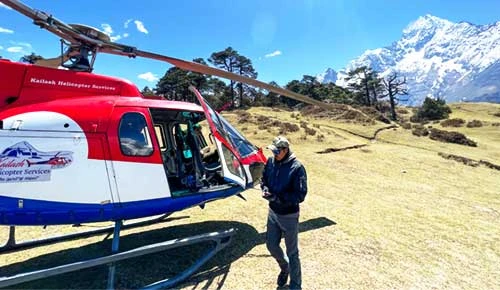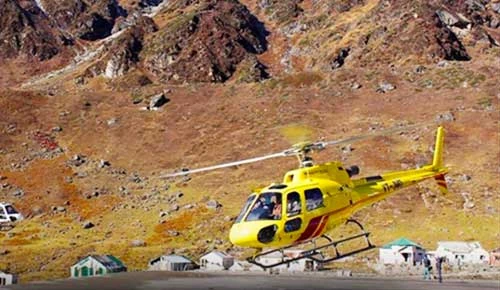Best Alternative Flight for Kathmandu and Lukla
Lukla, the gateway to Everest, is one of the most sought-after air destinations in Nepal. Its Tenzing-Hillary Airport is perched dramatically on a narrow ridge, offering one of the most thrilling (and sometimes nerve-wracking) landings in the world. Every year, thousands of trekkers flock to this airport to begin their Everest Base Camp journey.
However, during peak trekking seasons—spring (March to May) and autumn (September to November)—regular flights between Kathmandu and Lukla face significant disruptions. Flights often get diverted to Ramechhap, a smaller airport located 132 kilometers east of Kathmandu. This creates confusion, delays, and additional travel burdens for trekkers.
But there’s a better, more reliable, and scenic option: helicopter flights directly from Kathmandu to Lukla. In this guide, we’ll explore why flights are diverted, what challenges passengers face, and how helicopter transfers solve these issues.
Table of Contents
Beauty and Importance of Lukla: Gateway to Everest Majesty
Additionally, as we all know, Every journey to Everest begins in Lukla—a tiny Himalayan village perched at 2,860 m, surrounded by an awe-inspiring panorama of snow-capped giants. As you soar above the verdant Dudh Koshi Valley on your approach, the dramatic ridges of Ama Dablam, Thamserku, and Kusum Kangkaru suddenly emerge, drawing your breath away and signaling that you’ve truly entered the heart of the Khumbu region. Lukla isn’t just a transit point—it’s a rite of passage where trekkers first connect with the grandeur of the Himalayas.
Its rugged airstrip, carved into a mountain ledge, offers one of the most breathtaking aviation experiences on the planet. Early-morning flights treat passengers to fiery sunrise skies kissing Everest’s summit. Down below, the Sherpa settlements of Phakding, Namche Bazaar, and Khumjung glimmer like jewels amid Himalayan wilderness, highlighting how Lukla sits at the crossroads of culture and alpine adventure.
But Lukla’s importance goes beyond its scenic cameo—it’s the logistical foundation of virtually every Everest trek. From here, trails lead to Namche, the sacred Tengboche Monastery, and eventually Everest Base Camp. Local lodges, teahouses, trekking agencies, and porters converge in this hub, making Lukla a vibrant microcosm of Sherpa hospitality and high-altitude culture. It’s where your Everest journey begins in earnest, with introductions to local customs, warm meals, and your first hikes among towering peaks. Its strategic location, combined with its wild beauty, makes Lukla far more than just a flight destination—it’s the emotional launchpad to the world’s highest peak.
Everest Region Packages: Tailored Journeys Beyond Lukla
For travelers finishing a helicopter transfer to Lukla, the Everest region offers a variety of curated package treks tailored to different timelines, fitness levels, and preferences. One popular option is the 7-day Lukla–Everest Panorama Trek, ideal for trekkers short on time. This compact itinerary keeps altitude gain gentle, taking you through charming Sherpa villages like Khumjung and Phakding. Your reward? Stunning alpine views of Everest, Ama Dablam, and Lhotse from Everest View Hotel—without the full Base Camp climb. It’s perfect for those seeking the Himalayas’ essence in under a week .
If you have more time, the classic Everest Base Camp trek spans 12–14 days and balances adventure with acclimatization. Starting with the dramatic flight (or helicopter) to Lukla, your journey winds through Namche Bazaar’s vibrant teahouses, spiritual peaks at Tengboche Monastery, and icy landscapes of Lobuche and Gorak Shep. You culminate at Everest Base Camp and Kala Patthar, absorbing soul-stirring sunrises across Everest’s summit. This itinerary is a tried-and-tested bucket-list route—capturing alpine flora, Sherpa culture, high-altitude hardship, and breathtaking vistas at every turn .
For those seeking a luxurious edge, consider the Everest Base Camp Trek with helicopter return—an 11-day premium package combining trekking with aerial ease. After reaching Gorak Shep and Kala Patthar on foot, you’ll board a helicopter back to Kathmandu or Lukla. It’s the ultimate blend of intimate trekking and panoramic flight—saving effort while preserving the rich experience . This itinerary suits time-conscious adventurers wanting Everest’s highlights with fewer physical demands and added comfort.
Helicopter-Centric Everest Packages: Ultimate All-in-One from Lukla
Rising in popularity are Everest region helicopter tours—designed for travelers seeking maximum impact with minimal time. The most exclusive is the Kathmandu–Lukla–Kala Patthar/EBC–Kathmandu helicopter tour, typically a 4–5-hour round trip, offering spectacular flyovers with landings at Kala Patthar and Hotel Everest View. Prices range from US$1,250–1,500 for group flights and skyrocket to US$5,600–6,200 for private charters. This option delivers Everest’s majesty in comfort—breakfast with a killer view, photo ops without the altitude trek, and no teahouse nights.
For travelers open to partial trekking, there’s the Everest Base Camp helicopter tour from Lukla, where you trek to Gorak Shep but fly back via helicopter—blending trekking achievement with helicopter convenience. Shared flights cost around US$450 per person, while private charters (for small groups up to five) range US$1,400–1,800 . It’s an ideal half-and-half package: challenge low-altitude sections on foot, avoid the high-altitude exhaustion, and return stress-free.
Finally, premium Everest helicopter packages with overnight stay at Hotel Everest View offer boutique luxury. Expect a two-day itinerary with helipad landings, meals, lodge stays, and guided experiences—all priced between US$3,000 and US$5,000 . This is the Everest experience redefined: tailor-made, breathtaking, and utterly opulent.
Why Flights to Lukla Get Diverted to Ramechhap?
Here are some of the reasons why Lukla flight are diverted to Ramechhap during peak seasons:
Limited Runway Capacity and Air Traffic
Tenzing-Hillary Airport in Lukla has a very short runway—only 527 meters long—and can only accommodate small aircraft like Twin Otters and Dornier 228s. It can manage only a handful of takeoffs and landings each hour.
During high season, the volume of tourists increases sharply. Kathmandu’s busy international airport (TIA) cannot handle the high volume of Lukla-bound flights alongside regular domestic and international traffic.
To manage this, the Civil Aviation Authority of Nepal (CAAN) reroutes Lukla flights to operate from Ramechhap Airport (also known as Manthali Airport) during peak months.
Weather-Related Risks
Lukla is located in a mountainous region where weather conditions change rapidly. Fog, wind shear, and low visibility are common. Since there’s no radar or night landing system at Lukla, all flights must operate in VFR (Visual Flight Rules), meaning flights can only land and take off in clear weather.
When flights are delayed at Kathmandu due to early morning fog or congestion, they risk missing the narrow weather window in Lukla. Thus, operating flights from Ramechhap—closer to Lukla—gives them more flexibility. However, this comes at a cost for travelers.
Inconvenience for Passengers
Flying from Ramechhap requires:
- A 4-5 hour early morning drive from Kathmandu (starting around 1 AM)
- Overnight stay near Ramechhap for early morning flights
- Added stress, exhaustion, and travel fatigue
In some cases, even Ramechhap flights get delayed or canceled, causing further disruption.
Helicopter Transfer: The Best Alternative to Regular Lukla Flights
Helicopter transfers from Kathmandu to Lukla offer a premium solution to all the issues faced by fixed-wing flights.
Key Benefits of Helicopter Flights:
- No Road Transfers: Skip the long, uncomfortable drive to Ramechhap.
- Direct from Kathmandu: Board the helicopter directly from TIA Domestic Terminal.
- Weather Flexibility: Helicopters can operate in smaller weather windows, offering higher chances of departure.
- Fast & Scenic: Enjoy a 45-minute flight with panoramic views of the Himalayas.
- Less Cancellations: Helicopters are more adaptable than planes in terms of routing and landing.
- Personalized Service: Smaller group sizes (typically 5 passengers) and better comfort.
When Should You Choose a Helicopter to Lukla?
- If you're trekking during peak seasons (Mar-May, Sep-Nov)
- If your itinerary is tight and delays could affect your trip
- If you want a stress-free, scenic, and smooth start to your Everest adventure
- If you missed a Lukla flight or got stranded due to weather
Helicopter vs Fixed-Wing Flights: Comparison Table
Feature | Fixed-Wing Flight (via Ramechhap) | Helicopter Flight (via Kathmandu) |
Departure Location | Ramechhap (5 hrs drive from KTM) | Kathmandu (TIA Domestic Terminal) |
Duration | 15-20 min (after drive) | 45 min |
Flexibility in Bad Weather | Low | High |
Reliability During Peak | Moderate | High |
Luggage Limit | 10 kg checked + 5 kg hand | 15 kg total (approx.) |
Passenger Capacity | 15-18 pax | 4-5 pax |
Approx. Cost (Per Person) | $180-$225 | $625 |
Scenic Views | Limited | Excellent (360°) |
Addressing the Cost Factor
While a helicopter is more expensive than a regular flight, let’s break down the hidden costs of the standard route:
- Taxi to Ramechhap: $25–$40
- Hotel overnight near Ramechhap: $20–$50
- Time cost and missed trek days: Priceless
- Risk of last-minute cancellation
Considering these factors, a helicopter not only saves time but also reduces anxiety, uncertainty, and logistical pain.
"Paying a bit more upfront can often save your entire trek."
Booking a Helicopter to Lukla: Tips & What to Know
- Book Early: High demand during the season means seats fill up fast.
- Group Sharing: Helicopter cost can be reduced by sharing with others (usually 4–5 pax per flight).
- Weight Limit: Pack smart—helicopters enforce strict luggage limits.
- Weather: Though more flexible, weather may still affect helicopter operations.
- Permits: Ensure you have your TIMS and Sagarmatha National Park permits ready.
- Trusted Operators: Choose licensed, insured operators with Himalayan experience (e.g., Fishtail Air, Air Dynasty, Simrik Air).
Conclusion: A Smarter Way to Start Your Trek
The flight to Lukla is one of the most memorable parts of any Everest trek—but only when it goes smoothly. With increasing diversions, weather delays, and seasonal congestion, helicopter flights from Kathmandu offer a superior alternative that saves time, reduces stress, and elevates your trekking experience.
Don't leave your Everest dreams to chance. Book your Kathmandu to Lukla helicopter flight today and enjoy a seamless start to your Himalayan adventure.
Book Now Direct Heli Flight to Lukla or Contact Us for availability and group-sharing options.








